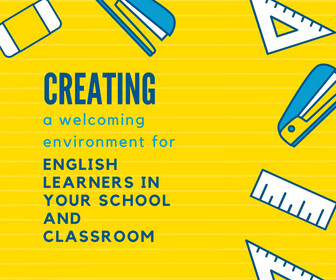As the school year begins, we, as teachers, think about how to welcome English learners (ELs) to our schools and our classrooms. School personnel at district registration centers or school offices give ELs and their families their first impression of U.S. schools. The ways in which we welcome them sets the tone for their experiences with us. It’s important to be empathetically aware that all ELs who have come to the U.S. have left behind school friends, neighbors, and, in many cases, family members. Many of them have experienced or are experiencing trauma, violence and chronic stress as refugees fleeing civil strife or war, being undocumented, and/or living in extreme poverty. Here are some strategies for supporting the smooth and positive entry of our new arrivals.
Develop meaningful partnerships with families from the start
When new families arrive at school to register their children, they may be stressed by the experience of getting into the building, finding the school office, and understanding what is needed. Staff members who are in charge of intake procedures and everyone who works with ELs (including office, custodial, cafeteria, transportation, guidance, specialist staff) should be prepared (professional development may be needed) to enthusiastically greet families and help them to feel valued, acknowledged and welcomed.
Begin by having conversations with families to learn about their child’s prior schooling and interests. Secure bilingual-bicultural professionals, support personnel, or translators to support the enrollment process. Lengthen the time allotted for these and future meetings (as much as double the time) to account for the time needed for translations and families to ask questions so that they may become familiar with American public-school customs. Explain the routines and practices such as the school calendar, start and end times of the school day, class schedule, afterschool activities available for their child, student codes of conduct, how parents can be involved with their child’s school. For example, one school engaged its ELs and their families in a video project that was filmed in the common languages of the district’s ELs. The videos include a tour of the school, interviews with school personnel and students, and showcase how the school is furnished to welcome new families.
Create welcoming physical spaces
The entrance areas-lobbies of school buildings, including our schools and centralized enrollment centers, should affirm the languages and cultures of our EL communities. A world map marking the countries that ELs come from, signs that say “Welcome to our School” in the various languages of ELs, pictures and drawings of the flags of their countries and labels around the lobby that indicate the name of objects in English and in the ELs’ first language can greatly serve to welcome EL families as an integral part of our school communities.
Pronounce newcomer’s name correctly
A person’s name is an important part of their social and cultural identity. It is worth every effort to pronounce our students and their family’s names correctly. Ask bilingual-bicultural representatives for help. Avoid the temptation to Americanize ELs’ names or create a nickname. Record the pronunciation of the child’s name or write it phonetically so that you remember it.
Build relationships with students.
Helping students to feel safe, acknowledged, valued and competent is essential for students social-emotional and academic growth. Greet new students with a friendly smile. Seat them with a buddy to help the student feel welcomed. Give lots of encouragement and praise for what ELs can do. Explicitly support students to build relationships with others. For example, a high school principal ensures newcomer ELs to sit with peers during lunch. The ESL teacher in that school engages newcomers in drawing a mural of their personal stories or writing a personal narrative about their life experiences. They share their story with the school principal and their teachers. Efforts such as these serve to help students to be known by others and build relationships with caring adults in their school.
Honor and value students’ language and culture
Recognize the rich resources that ELs and their families bring. These can greatly support us all (administrators, teachers, and students) in expanding our global awareness and supporting our students and families to be proud of and honor the rich heritage, home cultures, languages and competencies that they bring. When ELs see their home cultures and languages being honored in the classroom, their culture is validated and helps them to develop positive self- esteem
Teach English through content area instruction
Teach English through content (such as science and math projects). We achieve this by doing the following: Establish a learning environment that connects learning to students’ personal, social, and cultural interests and experiences; identifying key ideas and modifying instruction to involve ELs while still engaging the whole class. Instruction must be comprehensible to allow ELs access to the content. State EL standards can greatly help content area teachers to set language and content goals that are appropriate to their students’ levels of English language development. Content area teachers also need to identify core ideas, tap students’ background knowledge, and use visuals, think-alouds and other scaffolds to support student learning.
Use cooperative learning strategies
Small‑group configurations are essential for developing student-to-student relationships, engaging ELs in communicating about the subject matters that they are learning and providing practice opportunities to develop the academic knowledge and skills that are needed for learning. A helpful strategy for engaging in cooperative learning is to assign all students with roles that they can accomplish successfully (such as timekeeper, ‘ask the teacher’, illustrator- note taker, etc). It’s helpful, as it is with all that we do, to match the language proficiency levels of newcomers with the tasks that we assign; assign students to peers and small groups that they will work successfully; engage students in paired followed with group work; vary the role of students so they can have practice communicating in a variety of ways.
When we use these strategies, we can greatly help students to flourish in school and in their lives.
Judie Haynes is the author and co-author of 8 books. She is a former ESL educator with 28 years’ experience teaching K-6 ELs and 35 years’ experience working with content area teachers of ELs.
Debbie Zacarian is an education consultant with three decades of combined experience as a district administrator, university faculty member, and educational service agency leader. She has written and co-written 6 books (three with Judie Haynes) and more than 100 journal articles, chapters, and state and district policies.
Judie and Debbie are the co-authors of Teaching to Strengths: Supporting Students living with Trauma, Violence and Chronic Stress (with Lourdes Alvarez-Ortiz); and of Teaching English Language Learners Across the Content areas; and the Essential Guide to Teaching Beginning English Learners.








